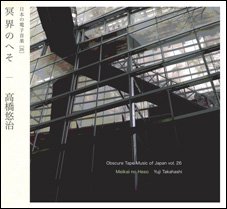
 |
|
 |
Format: CD Label & Cat.Number: Edition Omega Point OPA-026 Release Year: 2021 Note: unknown / unreleased tape pieces by now renowned Japanese composers: YUJI TAKAHASHI (1963! the longest piece here), KUNHARU AKIYAMA (1987), YORIAKI MATSUDAIRA (1984), YOSHIO HACHIMURA (1973), and "Music for Film Shikisokuzeku" by TOSHI ICHIYANAGI (1974)...
Price (incl. 19% VAT): €21.50 More InfoYuji Takahashi “Meikai no Heso” CDEdition OMEGA POINT Archive Series OPA-026 A collection of small pieces of tape music by renowned composers, that haven’t been talked about very much. All of them are premiere release on disc. tr.1 Yuji Takahashi (1938 -), Meikai no Heso (The Umbilicus of Limbo, 1963) (sound file) It is also known as Window to Antonin Artaud, or The Umbilicus of Limbo. it was performed in a version of tape and instruments - poetry reading of the French poet Antonin Artaud, which was modified on the tape, and bass instruments as well as percussion instruments. This is a live recording of Musicians Group: New Direction at Sogetsu Art Center, conducted by Toshi Ichiyanagi. At the beginning of the concert, Kuniharu Akiyama gave his commentary about the piece. tr.2 Kuniharu Akiyama (1929 - 1996), Jo-un Keiji sho (1987) (sound file) It is a segment of a body of work Sound Gift, that was commissioned by WDR (Westdeutscher Rundfunk) for a show to celebrate John Cage’s 75th birthday. A short text, “Kumo Kumo-wo Joshi Keiji-suru (Kumo=Clouds, Keiji=Cage)”, which was a poetry reading by Akiyama, was looped in the tape, which then overlapped with Haiku about clouds (including English and German), words related to Zen ( in which Cage immersed himself), and sounds. By the way, an English version of Haiku was read by Ayuo Takahashi. tr.3 Yoriaki Matsudaira (1931 -), Constellation (1984) (sound file) This is a work by using UPIC device developed by Iannis Xenakis (which can translate graphical images into sound). Here is Matsudaira’s commentary. “I decided to draw the constellation which we can see in Japan, and chose to fade in colours depending on the brightness of each star. Each of us was supposed to indicate the tone by images, and I remember that I decided to divide the sky into four sections to change the tone little by little. tr.4 Yoshio Hachimura (1938 - 1985), Catch in the air (1973) (sound file) It was produced in 1973 at NHK Studio of Electronic Music. Some Japanese traditional instruments, piccolo, tuba, violin, piano as well as electronic sounds were edited on the tape. Its sharp materialistic sound is characteristic of this composer. tr.5 Toshi Ichiyanagi (1933 -), Music for Film Shikisokuzekuu (1974) (sound file) The visual of Shikisokuzekuu is described as follows; A letter of Heart Sūtra is projected one by one on the screen rapidly. From the middle of the film, religious paintings appeared with subliminal effect, and flickering vivid colours were added. That gave the audience a dizzy sensation.” The music is mixed barbaric rhythm, electronic sound and Japanese traditional instrument. omega-point.shop-pro.jp/?pid=159022056 |
| © 2007 Drone Records | | Celler Strasse 33, 28205 Bremen, Germany | Privacy and cookies policy | Impressum / Allgemeine Geschaftsbedingungen / Haftungsausschluss | Links to the scene |